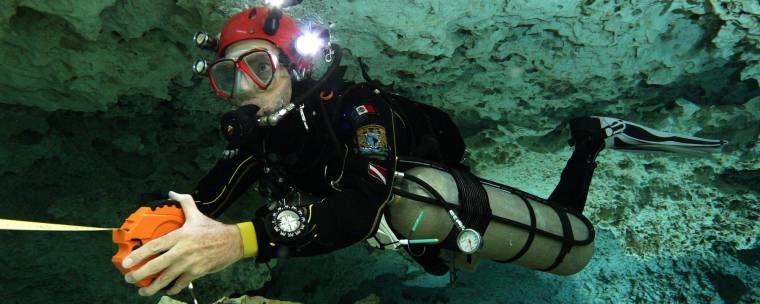
This field laboratory, associated with the Museo del Desierto in Coahuila, Mexico, is led by Jerónimo Avilés, an underwater speleologist and director of the Instituto de la Prehistoria de América AC. It's the first place where items from underwater archaeological discoveries by his team are analyzed before they are sent to other laboratories in Mexico. In one room, for example, fossils go through a dehumidification process to prevent any fungal colonization, not uncommon in such a tropical climate.
The lab mostly houses 3-D printed replicas of skeletal remains found in the submerged caves in the state of Quintana Roo. Among them are copies of the skulls of humans who inhabited the Yucatán Peninsula during the Pleistocene-Holocene transition, roughly 13,000-8,000 years ago.
Recent work has focused on describing the morphological diversity of those individuals. Avilés and team led by Mark Hubbe of the Ohio State University compared the anatomical landmarks of four of the Pleistocene-Holocene skulls with those of crania from modern populations across the globe. Their results, published January 29 in PLOS ONE, indicate that each ancient skull shared features with a different modern population, suggesting a high degree of morphological diversity among these individuals, and, potentially, among early North American settlers.
On February 5, researchers led by Wolfgang Stinnesbeck of Heidelberg University, reported in PLOS ONE the discovery of a newly recovered skeleton from the submerged Chan Hol cave in Quintana Roo: a woman who lived in this region about 10,000 years ago and who has been named Ixchel by the research team.
Stinnesbeck and colleagues also analyzed her skull shape — a more general assessment than the detailed 3-D landmarks mapped by Hubbe's team — and that of the other Quintana Roo individuals. The group found that the skull shape of this population differs from that of the individuals inhabiting central Mexico during the same period, pointing to the overlapping existence of two different human groups in what is now Mexico.
Together, these two studies bring fresh support to previous analyses that have suggested a high craniofacial diversity during the early days of human settlement in North America. The remarkable degree of cranial variability within the same region is, furthermore, what distinguishes the Quintana Roo specimens from other collections of studied skulls.
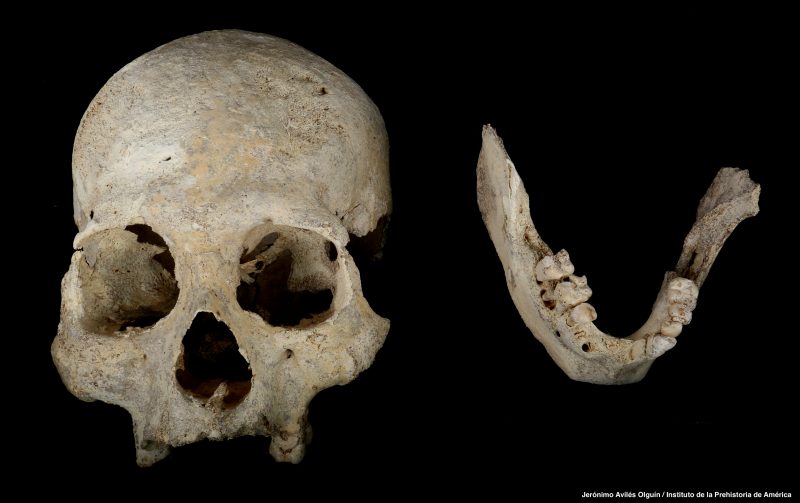
Ten skeletons, including Ixchel, have been discovered in the submerged caves of Quintana Roo, most of them fortuitously. In the early 1990s, explorers found the first one, now known as Eva de Naharón. It is one of the oldest skeletons in the Americas — between 13,300 and 13,600 years old.
From Eva to Ixchel, they all have been found underwater. Avilés, who led the group of explorers that surveyed the cave near the town of Tulum where Ixchel was found, explains in Spanish that the remains were located eight meters below the water's surface on the floor of a shallow tunnel. The trip to get there started in a cenote, a freshwater pool often connected to a warren of submerged caves, but the researchers then had to travel more than 1,000 meters underwater in pitch-black caves to find Ixchel. Instead of swimming, they used diver propulsion vehicles, also known as scooters, which cut the travel time in half.
In Ixchel's day, these caves were dry. Before the end of the Last Glacial Maximum, around 19,000 years ago, the Yucatán peninsula was not the low-lying plain it is today. The sea level was more than 100 meters lower than it is nowadays, and with subsequent deglaciation it reached present-day sea levels about 4,500 years ago.
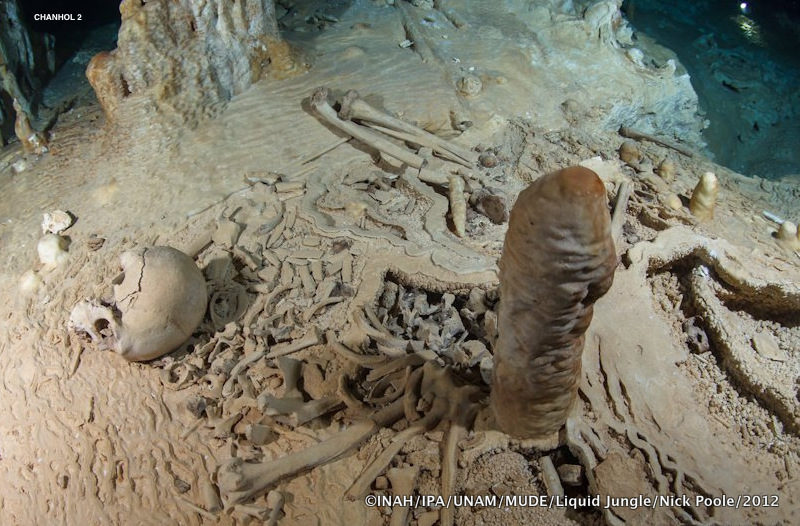
Conventional radiocarbon dating is challenging in most of these skeletons, as collagen is barely present, possibly as a result of alternating exposure to saltwater and freshwater environments. Instead, by using the half-lives of uranium and thorium isotopes to date the embedded mineral deposits such as stalagmites, Stinnesbeck and colleagues have been able to better estimate a minimum age for some of the specimens.
Their dating places them among the oldest skeletons in the Americas, and their quantity is also the biggest North American collection from the Pleistocene-Holocene transition. There are fewer than 20 skeletons from that time in the Northern Hemisphere, says Hubbe. Quintana Roo is the only place where archaeologists have recovered more than one individual from the same region and time period, he explains.
Furthermore, "a lot of these skeletons are articulated," meaning bones are still connected, says Tom Dillehay, an anthropologist at Vanderbilt University who did not participate in this work, "whereas most of the early human remains in other parts of the Americas are usually fragments of bones." It's very rare, he says "to find a complete articulated human skeleton dated to the late Pleistocene in the Americas."
Morphological diversity within the population
The uniqueness of the Quintana Roo collection motivated Hubbe and his colleagues recently to compare the morphology of four well-preserved skulls found in the submerged caves of southeastern Mexico. The team scanned the skulls using computed tomography, identified their representative 3-D landmarks, and compared each to a reference series of 18 specimens from modern populations across the globe. The comparative analysis associated each ancient skull with a different population, hinting to a high degree of morphological variety within the population.
The skull of Eva de Naharón, the oldest individual included in this comparison, is more similar to Arctic North American specimens than to other modern populations, while the cranium of El Pit I, the second-oldest at 13,400-12,100 years old, aligned more closely with the modern European samples in the database. The skull of Las Palmas, another ancient individual the team analyzed, was most similar to the modern Asian and Native American samples.
The authors advise caution when interpreting these associations, especially with the two oldest samples, as they are both highly fragmented and their comparison was only based on a few landmarks. Muknal, the fourth skull included in the study, did not show a strong resemblance to any other specimen from the reference series. Given the small number of landmarks that could be identified in these skulls, it was not possible to compare them to one another.
Based on the few studies that have recovered genetic material from the time when these individuals lived, "the population was genetically very homogeneous," says María Ávila-Arcos, an evolutionary geneticist at the National Autonomous University of Mexico who did not participate in this study, and "only recently we see differentiation between different regions in the Americas." But "maybe there was more diversity than what we anticipated, and that's reflected in differences in the skull morphology," she adds.
She cautions that cranial morphology can be "subjected to environmental adaptations or just drift," and that different skull morphologies do not imply different ancestry.
Jennifer Raff, an anthropological geneticist at the University of Kansas who was not involved in the study, agrees that skull shape "shouldn't be used uncritically as a proxy for ancestry, but rather as a way of developing hypotheses and models for testing."
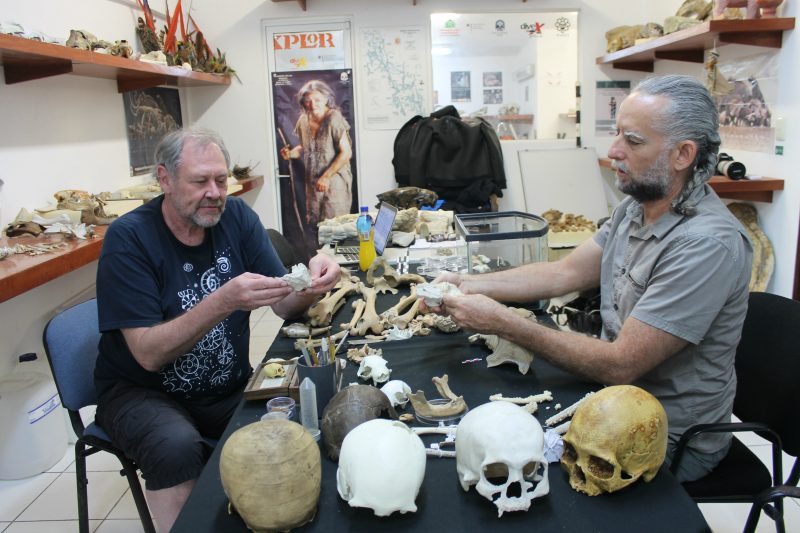
For instance, he asks for caution when talking "about the settlement of the Americas as if it was only one thing." The stories of settlement in each hemisphere are different, he argues. Pleistocene skulls from South America are more homogeneous. During human migrations from north to south, Mexico might have acted as a geographic funnel, Hubbe and colleagues hypothesize. South America perhaps only received populations representing a small fraction of the total diversity found in North America.
A potentially isolated population
Ixchel was about 30 years old when she died, and her life appeared to have been a difficult one. Her skull bears signs that she likely survived up to three cranial traumas, and that she was possibly affected by a treponemal bacterial disease linked to cranial deformity, according to the study by Stinnesbeck's team.
"One of things that I found most interesting about the skull from the woman of Tulum is just how much of an insight it gives us into her life and the lives presumably of the people in her group," says Raff.
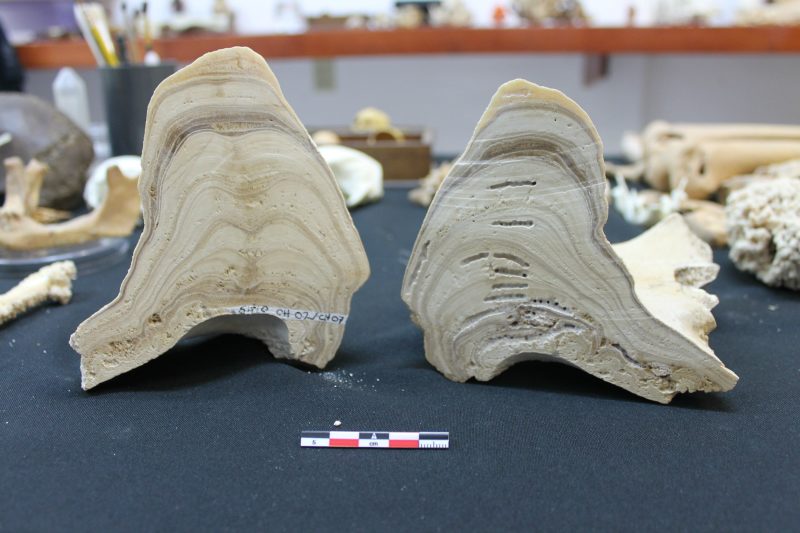
Based on the cranial index, which gives a hint about how round the skull is, the team also describes that the Quintana Roo skulls are mesocephalic. That is, they are more spherical than skulls found in other sites in North America from that same period, which are often classified as dolicocephalic — longer and narrower from back to front. This was a rare find, as skulls found in central Mexico with estimated ages of more than 9,000 years are mostly dolicocephalic.
In their study, Stinnesbeck and colleagues imply that these differences point toward two different populations inhabiting Mexico as early as 12,000 years ago, populations that were morphologically distinct either because their geographical origins were different or because they went through fast local adaptations to their environment.
"To me as an archaeologist," says Dillehay, "diversity can imply several things." First, "you do indeed have multiple migrations of people coming in over time," from related populations, but with differences within those populations. And then, "those differences are accentuated over time once you are in America by perhaps becoming geographically isolated and adapting to different environments over time."
These hypotheses need to be tested using genetics, and that is the next goal of Stinnesbeck and his colleagues. So far, the only genetic analysis on the Quintana Roo skeletons was done for the young Naia. The study, led by James Chatters, an archaeologist at Applied PaleoScience in Washington State, concluded that Naia's mitochondrial DNA showed a Beringian origin, supporting a shared ancestry with modern Native Americans, in spite of differences in craniofacial morphology and dentition.
These genetic results, published in 2014, were later questioned by other scholars. An independent analysis of the data found no evidence for the preservation of authentic ancient DNA and concluded that the sample might have gone through at least two contamination events.
Stinnesbeck and his colleagues have also previously tried to extract DNA from their samples, but the lack of mineralized collagen — from where scientists can extract ancient DNA — complicated the endeavor. They will soon, nonetheless, try once more, hoping this time it works.
"It's quite likely that this group was ecologically isolated," says Stinnesbeck. Other studies of the underwater caves that he and Avilés have been involved in have described the evidence of extinct, likely endemic, animals that also inhabited the region during the late Pleistocene. This includes a giant ground sloth, a peccary, a felid, and a few others yet to be published. This endemism points towards a highly isolated environment, "like a continental Galapagos," Stinnesbeck says.
M. Hubbe et al., "Morphological variation of the early human remains from Quintana Roo, Yucatán Peninsula, Mexico: Contributions to the discussions about the settlement of the Americas," PLOS ONE, 15:e0227444, 2020.
W. Stinnesbeck et al., "New evidence for an early settlement of the Yucatán Peninsula, Mexico: The Chan Hol 3 woman and her meaning for the Peopling of the Americas," PLOS ONE, 15:e0227984, 2020.
Alejandra Manjarrez is a freelance science journalist. Email her at alejandra.manjarrezc@gmail.com.



lbs?No. Kg![Link] Be nice to that kitty!